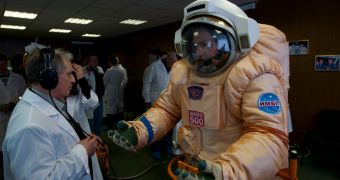The Mars 500 experiment will undoubtedly be one of the most unusual, and in some way cruel, experiments ever undertaken by humans. Six pseudo-astronauts will spend a total of 520 days locked inside a set of containers that will closely mimic the conditions a real crew of space fliers would be subjected to during an actual trip to the Red Planet. At this point, the selection process of how they will get on board has yet to complete, but a final decision is not far off, the European Space Agency (ESA) reports on its official website.
Only two Europeans will be part of the experiment, though there are four candidates altogether. On March 22, they took a pause from their regular astronaut training – which is mandatory for all those undergoing the selection process – to meet the press. The conference took place at the ESA Technology Center ESTEC, which is located in Noordwijk, the Netherlands. According to those in attendance, there was nothing remotely similar to the solitude these individuals would experience inside the experiments, as they were surrounded by people asking them all sorts of questions about how they felt about their prospective selection.
The four are Belgian Jerome Clevers, Arc’hanmael Gaillard and Romain Charles, both from France, and Colombian-Italian Diego Urbina. Of them, only two will get to board the mock-up spacecraft that will take them to “Mars,” alongside three Russian participants and a Chinese nominee. The first full-time experiment to simulate a real trip to the Red Planet will begin next summer. According to officials, the journey is divided into three segments, a 250-day trip to the planet, a 30-day stay on its surface, as well as a 240-day trip back home.
“Mars is the ultimate goal of the global human exploration program. In addition to developing the necessary space infrastructure for exploration missions, ESA’s Directorate of Human Spaceflight also has an ongoing program of ground-based analogues and ISS research activities to make sure that our astronauts are as prepared as possible in the future for the physical and mental demands of long-duration exploration missions, and to develop countermeasures against any adverse effects of such a mission. Mars500 isolation study is a major milestone in this. The cooperation between ESA and Russia in this experiment is also an asset,” the ESA Director of Human Spaceflight, Simonetta Di Pippo, said at the conference.

 14 DAY TRIAL //
14 DAY TRIAL //